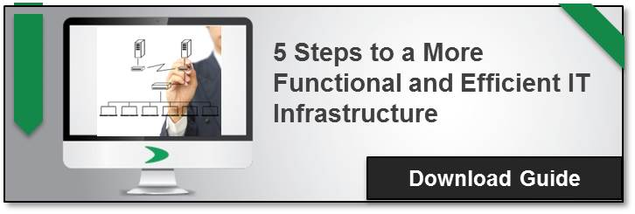Present Blog – IT Thought Leadership
Blog Present-IT thought leadership
Blog Present-IT thought leadership
IT thought leadership blog for CIOs and CTOs in Canada seeking resources to drive IT as a business contributor: hybrid cloud, infrastructure, managed services and security and IT recruitment.

The start of a new year always brings about resolutions, and this can also apply to IT departments. The reality of daily operations is that in many small and medium enterprises, certain basic elements, although necessary, can be neglected, causing an impact on several levels.
We regularly see IT departments operating in reactive mode, whereas the implementation of some policies and procedures would help to reverse this way of functioning.
Here are three often overlooked areas we recommend organizing in your IT department in 2015:
1. Develop a comprehensive inventory of your equipment
It is important to establish a rigorous inventory and keep it updated with each new purchase of hardware, software, license renewal, with the expansion of the company's premises or any other event that involves a change.
The main purpose of an inventory is to centralize relevant information on the life cycle of each element, for optimal visibility that will help plan actions and renewal budgets.
For example, the IBM and Microsofts of the world, are charging substancial reinstatement fees for late license renewal, therefore it is very important to plan ahead to avoid unnecessary costs.
List of items to be inventoried
• Equipment
• Servers: performance, memory, disk space, expiration of warranty ...
• Desktops, laptops, tablets: model, acquisition date, operating system, expiration of warranty ...
• Storage units; tape or disk
• Fixed and portable phones: model, date of purchase or rental start, rental end date, vendor ...
• UPS and batteries: model, capacity, date of installation, durability and estimated replacement date ...
• Networking
• Software and licenses
• Services et contracts
The inventory will allow you to quickly identify new hardware needs, capacity, etc. when the business is growing.
2. Optimize the data backup process
Data backup is an important responsibility, however it does not always receive the level of attention required. The prevailing rule in this matter is 3-2-1, that is to say, keep three copies of your data (including a production data set), on 2 different media types, one of which is offsite.
Each element of this rule meets a vital need for companies:
• 3 copies are used to maintain both optimal production speed and to do backups
• 2 different medias that can compensate for the possible breakage, loss or corruption of data on one of them
• 1 copy off-site in case of natural disaster, theft or fire at the primary site
3. Effectively manage the deployment of equipment to new employees
When companies have computers available, new employees often receive a device that has already been used and on which several tools are already installed. To avoid multiple manipulations, we recommend having a standard format of tools, ie a digital image of a new desktop.
You need to create an "image" for each profile type of employee (ie accounting, production, procurement, sales ...), which permits you to set up a functional workstation from day one. This process also helps to provide the documentation associated with the different tools.
Another aspect related to hardware deployment is the management of passwords and accesses. Have the passwords of the tools from the employees who is leaving been changed? Does a single password allow access to everything? Security requires effective management and classification of passwords and rights.
To remember
With this back to basics of the critical elements of IT management, we wanted to above all highlight the need to have very solid core processes that do not impede the operation of the business, but rather enhance it. Shortcomings at this level will have widespread implications on the business and employee productivity. And possibly some legal implications for audits.
More than a New Year's resolution, the advancement of the 3 points above should be a goal for the year.
Crédit photo : © DAVIPIX - Fotolia.com
About Blog
The right use of technology addresses business challenges and drives business growth in all areas of an enterprise. We hope this blog will offer insight into developing strategies and tactics to enable you to identify those key drivers of growth and keep pace with and anticipate the rapid technology change of today.
Posts by Topic
- IT infrastructure (115)
- IT security (90)
- IT Innovation (58)
- Trends (50)
- Cloud (46)
- Managed services (45)
- Mobility (38)
- Digital transformation (29)
- CIO/IT leaders (28)
- Events (27)
- News (22)
- Security (17)
- IBM (16)
- Microsoft 365 (16)
- Disaster recovery (DR) (14)
- High availability (12)
- Recruitment (12)
- Storage (12)
- Big Data (11)
- Collaboration (11)
- AI (9)
- Case study (9)
- Office 365 (9)
- BYOD (8)
- Customer Experience (7)
- Hybrid Cloud (7)
- Current events (6)
- SAP Hana (5)
- Business intelligence (BI) (4)
- Converged infrastructure (4)
- Convergence / Hyper-convergence (4)
- Copilot (3)
- Virtualization (3)
- Future of retail (2)
- trend (2)
- Backups (1)
- Beacon (1)
- Blog Migrations (1)
- Contests (1)
- Infrastructure TI (1)
- Innovation TI (1)
- IoT (1)
- MDM (1)
- Retail (1)
- Stockage (1)
- Virtualisation (1)
- blockchain (1)
- cio (1)
- replication (1)
- Étude de cas (1)

